
Just a few more days, and fall will officially be here. And with it comes the best time of year to plant many of our California natives.
Shorter days and cooler nights mean less stress on the plants as they’re settling in. Their roots will start to venture out into the still relatively warm soil. Winter rains will help to further establish the plants.
By next spring, your natives should be well in tune with our natural cycle of cool, moist winters and warm, dry summers.
Why Natives?
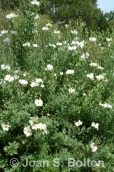
Choosing plants that are already adapted to our climate and soil is a no-brainer. Natives tend to attract fewer pests and diseases because they’ve already figured out how to survive here. And they benefit wildlife, providing both food and shelter for birds, butterflies and all sorts of beneficial insects.
But just grabbing any old plant that bears a “native” tag is not a good idea. Just like plants from anywhere else in the world, any particular California native may prefer sun or shade, little or lots of irrigation, and sandy or heavy soil. You still need to match the plant to where you intend to place it.
Taking that one step further: you must pay attention to your natives, too, especially for their first year or two. Just because they’re native doesn’t mean you can stick them in the ground, walk away and expect them to behave beautifully, much less even survive. I once had a client who bought a few dozen natives, sort of buried them in the ground, then was bewildered when they all died within a year.

There was no irrigation system or water source in sight. When I asked if she had even watered them in when she planted them, she replied, “They’re natives. I had to water them?”
That said, many natives don’t need endless buckets of water or much fuss. But they are living beings. Early on, you can not ignore them — as to where you plant them or how you care for them once they’re in the ground.
Smaller Natives
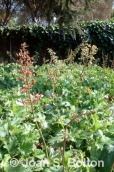
If you’re looking to add a few perennials or evergreen bulbs, island alum root (Heuchera maxima), Pacific Coast hybrid iris (Iris PCH hybrids) and hummingbird sage (Salvia spathacea) do well in filtered light or with afternoon shade.
Island alum root forms foot-tall clumps of crinkly green leaves. Slender stems bearing scores of tiny pinkish-white flowers appear in spring. Pacific Coast hybrid iris bloom in pretty combos of purple, lavender, bronze, yellow, cream and white, with the flowers emerging just a few inches above short, grassy blades in spring and early summer. Hummingbird sage spreads 4 to 5 feet wide, with dark magenta flower spikes appearing above arrowhead-shaped, apple-green leaves in spring and summer.
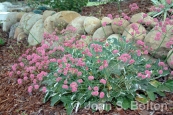
In full sun, San Miguel Island buckwheat (Eriogonum grande var. rubescens) bears hot-pink, ball-shaped flowers in late summer on stiff stalks that sit a foot above low-growing oval, blue-gray-green leaves. The flowers turn rusty brown as they age, matching the fall color of local hillsides.
A number of ground-hugging California lilacs (Ceanothus) flourish in sun as well, including Centennial and Anchor Bay, both of which bear wands of dark blue flowers; and Heart’s Desire and Hearst Ranch buckbrush, which bear flowers in light blue.
Shrubs
Depending on the plant, California lilacs also form medium to large, sprawling shrubs. (Yet another reason to read the plant tag.) Among the many larger varieties are Yankee Point, which grows up to 5 feet tall, spreads 10 to 12 feet wide, and begins bearing plump wands of medium-blue flowers in late winter; Concha, which grows 6 to 8 feet tall and wide, and bears dark blue flowers; and Ray Hartman, which stretches 18 to 20 feet tall and wide, and bears clusters of medium-blue flowers.

Shrubby manzanitas (Arctostaphylos) produce tiny, whitish-pink flowers in early spring. But the real show is the bark, which develops a rich, satiny, dark-red hue over time.
Some species can be touchy in the garden — Howard McMinn is one of the best. Give it full sun and good drainage and it will grow into a beautiful, mounding focal point about 7 feet tall and 10 feet wide.

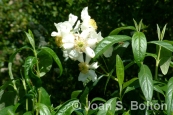
Blooming in pure white are bush anemone (Carpenteria californica) and Matilija poppy (Romneya coulteri).
Bush anemone grows 6 to 8 feet tall and 4 to 5 feet wide. Its spring and summer flowers are similar to a camellia’s, with five large, flat, white overlapping petals and a sunburst of yellow stamens in the center.
Matilija poppy bears plate-sized, crinkly white flowers with golden-yellow pompom centers in late spring and summer, and grows crazy wild, with blue-green, upright stalks towering 6 to 8 feet tall and wide.

St. Catherine’s lace (Eriogonum giganteum) forms large mounds, up to 8 feet tall and 6 feet tall, of flat-topped clusters of tiny ivory flowers that turn rusty brown as they age. Like the much smaller San Miguel Island buckwheat, those tones give the sense of fall out in the wild.
For flowers in shades of lavender, purple and blue, look for shrubby sages (Salvia), including Cleveland, Winifred Gilman and Allen Chickering sage. Many of the native sages have gray foliage, which reflects the sun and keeps the plants cooler in hotter conditions.
California fuchsia (Epilobium or Zauschneria) blooms later than many native shrubs. Its orange tubular flowers appear in late summer and early fall and attract scores of hummingbirds. One of the most popular selections is Catalina fuchsia (Epilobium canum ‘Catalina’), which grows 3 feet tall and 5 feet wide, and bears slender, gray-green leaves that really offset those bright orange flowers.


For even bigger and bushier native shrubs, consider flannel bush (Fremontodendron ‘California Glory’), toyon (Heteromeles arbutifolia) and lemonade berry (Rhus integrifolia).
Flannel bush grows 20 feet tall and wide, bears large, flat, gold flowers in early spring, and requires impeccable drainage and absolutely no summer irrigation.
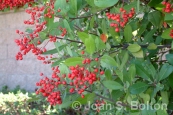
Toyon is much more adaptable to garden conditions, grows 8 to 15 feet tall and wide, and bears stunning red berries in fall and winter.
Lemonade berry grows up to 20 feet tall and wide. It bears dense, leathery leaves that take well to pruning, which makes it a good choice for a large hedge. Birds love the little sticky summer fruit, which can be harvested and used to add lemon flavoring to drinks.
≈
How to Plant Natives
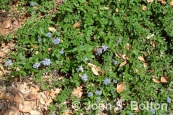
Water your natives the night before you plant them, to make sure their container soil is moist and will hold together.
Dig each hole as deep as the container, and at least twice as wide. Roughen up the sides and bottom of the hole to encourage emerging roots to find nooks and crannies to follow into the surrounding soil.
Break up any dirt clods that you excavated. Fill the bottom of the hole with an inch or two of dirt, so that the crown of the plant ends up an inch or so higher than the surrounding soil.
Place the plant in the hole, then fill the hole with the soil that you excavated.
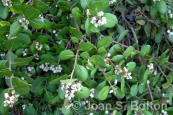
Shape a watering basin around the plant at least a few inches wider than the hole. Add an inch or two layer of mulch, then deep soak the plant.
In general, there’s no need to amend the soil. Provided you’ve matched the plant to the site, the plant should be able to extract all the nutrients it needs from the existing soil. Indeed, add too much nitrogen and you can end up with a leggy native that lives only a few years.
It is a good idea, however, to add a layer of organic mulch, such as finely shredded bark or compost. As the mulch slowly breaks down, it will replenish nutrients, keep the soil moist longer and encourage beneficial soil microorganisms to flourish.
≈
Seeds of Wisdom
Water your newly planted natives every few weeks if winter rains are not heavy or frequent.
≈
Copyright, Joan S. Bolton. All rights reserved. Reproduction of text or photos in any form is prohibited without written permission.
≈
